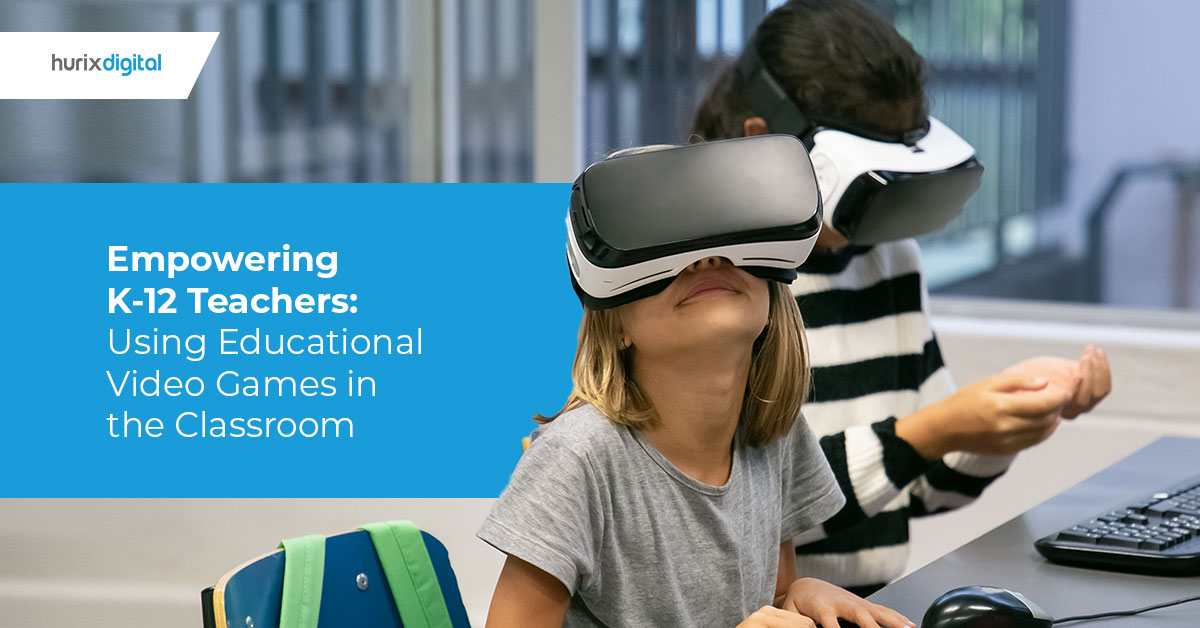Empowering K12 Teachers: Using Educational Video Games in the Classroom
There is no denying that EdTech solutions including educational video games have been a welcome addition for students receiving their k-12 education. Game-based learning, also known as interactive learning, harnesses the power of technology and time-tested gamification in education to make learning fun for students. However, game-based learning solutions also provide teachers with a helpful tool for curriculum enhancement.
This blog discusses 8 demonstrable ways that games developed by top K12 education companies empower educators.
Table of Contents:
- Game-Based Learning Leads to More Engaged Students
- Interactive Learning Complements Traditional Instruction
- Reinforce Key Concepts (Aid in Retention)
- Immediate Assessments (Tracking Progress)
- Adaptable to Various Learning Styles/Bridges Learning Gaps
- Enhances Problem-Solving & Critical Thinking Skills
- Supports Students in Self-Correcting
- Helps Students Develop Transferable Skills
- Conclusion
Game-Based Learning Leads to More Engaged Students
Educators know that engaged students are better students. So, what engages students? In a word: fun. That’s why educators have prioritized gamification in education for thousands of years.
Thanks to the incredible speed at which technology has evolved in recent decades, today, nothing is more engaging for students receiving their K12 education than game-based learning. Fortunately, top K12 EdTech companies are delivering interactive learning games that provide the fun students crave, and the knowledge educators must impart to ensure a successful K12 education.
Interactive Learning Complements Traditional Instruction
Game-based learning solutions provide curriculum enhancement rather than replacing traditional teaching methods. Indeed, K12 solutions from top K12 education companies are carefully vetted to ensure they have been designed to complement the educator’s existing lesson and instruction plans.
For example, an educator explaining the division of human cells in a science lesson, need not worry that EdTech solutions will replace them as educators. Instead, the game would likely be played by students after providing oral or textbook instruction. In other cases, a game may be used to remind students how the cell division process works before they take an examination. In either case, the selected EdTech solutions are designed to support other teaching styles to bolster curriculum enhancement, rather than serve as a replacement.
Also Read: How to Use Educational Games to Promote Social-Emotional Learning in the Classroom
Reinforce Key Concepts (Aid in Retention)
Game-based learning in K12 education helps to reinforce key concepts. Consider that in years past, flashcards or other repetitive tools were used to memorize key dates, basic math, spelling, etc. Today, EdTech solutions have moved these repetitive actions to an interactive learning experience on a computer screen or tablet.
Repetition helps students to retain the information being conveyed, and the games developed by top K12 education companies ensure that they have fun while doing so.
Immediate Assessments (Tracking Progress)
One of the most useful features of incorporating game-based learning into the classroom is in-game assessments. Rather than waiting until the educator has time to grade an essay, assignment, or test, in-game assessments are immediate.
This empowers educators in several ways. Firstly, it allows them to identify students who are struggling quickly. Teachers can then make adjustments necessary before the student begins to fall significantly behind their peers.
Similarly, in-game assessments help educators to identify students who are excelling in specific material and may need to be challenged with more difficult games, material, assignments, etc.
Adaptable to Various Learning Styles/Bridges Learning Gaps
There has been a lot of debate about whether “learning styles” are indeed as defined as visual, auditory, kinesthetic, etc. What is not up for debate for most educators is that many students have, at the very least, a preferred learning style. K12 EdTech companies excel in creating games that will appeal to students who have varied preferred learning styles.
More often than not, games from the top K12 education companies will appeal to multiple senses at once. With vibrant colors, exciting or engaging sounds, and interactive gameplay, nearly all students will find that games appeal to one of their favorite sensory learning styles.
Enhances Problem-Solving & Critical Thinking Skills
Interactive learning in the classroom can also support educators in their quest to help students become reasoned problem-solvers. After all, to advance to the next level or successfully win a game, students at all levels of K12 education will need to solve problems.
Indeed, games are essentially problem-solving exercises in which students must make decisions either on their own or as part of a team. Regardless of the subject of the game, students are required to make decisions, thus forcing them to think critically and arrive at the correct solution.
For example, in games focused on ELA, students will have to make decisions regarding punctuation, spelling, and proper grammar usage. In science-based games, students may encounter problems such as understanding why a plant won’t grow or how to feed their community.
Also Read: Is Game-Based Learning the Future of Education?
Supports Students in Self-Correcting
In years past, educators often had to walk through their classrooms, looking over the shoulders of students as they worked on various assignments. When a student was on the wrong path with solving a complex maths problem, it would be up to the teacher to notify them of their error so that they could try again. Game-based learning solutions, by contrast, allow students to self-correct on the spot, saving time pursuing the wrong solution, and immediately determining how to arrive at the correct solution.
Helps Students Develop Transferable Skills
Game-based learning solutions from leading K12 EdTech companies help educators in ensuring their students develop transferable skills. For example, digital literacy is a skill that will serve students throughout their life, so developing this skill from an early age will give them an advantage.
Collaborating with others is also an essential skill that students will need to thrive in the next grade level, or beyond school. Educators can divide classrooms into teams to compete against one another in an interactive learning game to bolster collaboration, communication, adaptability, and countless other skills that will help the student grow into well-rounded adults.
Conclusion
Interactive learning solutions from K12 EdTech companies should always support the students and the educators. Although it is important to motivate and engage students, it is equally important to empower educators who are responsible for imprinting knowledge on future generations.
Any game that does not provide curriculum enhancement for both educator and student should be removed from the classroom. Fortunately, most top K12 education companies will allow educators to try each game via a demo before implementing it in the classroom.
Game Learning, a leading EdTech company, has partnered with Hurix Digital, one of the world’s leading digital curriculum providers to offer game-based learning solutions for the K12 curriculum. To learn more, or to request a free demo, contact Hurix Digital today.

Matt Massman is the Founder and CEO of Game Learning, a leading EdTech company based in Los Angeles. Massman has spent his career developing educational tools to improve the way students learn. Previously, he launched Vinci Academy with Dr. Dan Yang. As Founder and CEO of Mass Equity, a privately held real estate development company, he has facilitated more than $1 Billion in developing preK-12 educational facilities.









